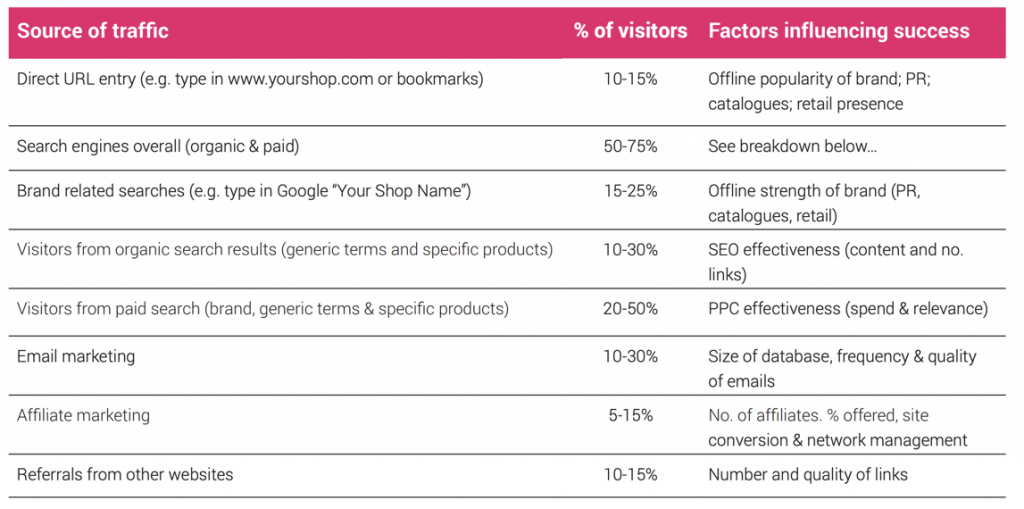Contents
Or read the White Paper below ...
We are sometimes shocked by the naivety of retailers – especially start ups – when it comes to getting traffic.
People imagine that a spanking website plus SEO will generate £1m in short order. In fact, it’s pretty hard work
nowadays, you need time, money, planning, management and measurement.
These are the things you need to run a business. In addition there are no silver bullets such as Facebook and Twitter.
This approach may work if you are a large brand or retailer with a lot of latent demand, but simply won’t cut the mustard for the smaller company.
This article summarises where and how online traffic will come to your eCommerce website.
Before we look at this, let’s consider how much traffic you will need for your thriving business. Many smaller businesses do not really have an idea about how to plan this, although experienced retailers will work this analysis to really drive their sales.
For those who don’t know, here’s some guidance:
Now you have the model, play with your anticipated figures to derive a sensible and achievable plan for the traffic levels necessary to hit your financial target.
Traffic will come from various sources so include a line item in your spreadsheet for each of these sources.
As a rule of thumb, based on our analysis of typical retail websites, this is where your visitors could come from on a fully executing website:

These are the people who type in your URL or the name of your brand into Google. Getting people to do this is a function of your offline rating or marketing activity.
For example, an article in the Sunday supplements can motivate a lot of people to search for your brand.
These activities could include a catalogue drop or word of mouth. Or a follow-up to a visit to a shop.
It is assumed that retailers are already active in this regard because after all, the concept is well understood.
However, a wholesaler with no direct route to consumers may struggle with this.
The direct marketer’s most powerful and cost-effective tool is email marketing.
You should build up your email database at the earliest, as it is the single most cost-effective repeat marketing activity. It generally converts at twice the rate, as these are your loyal customers returning.
Read our article about ways to increase the size of your email database. Consider putting a pop-up on your website to encourage email subscriptions and incentivise your visitor to do so.
Here’s a checklist of what you need to manage when it comes to email marketing:
Our advice is to send as many emails as your customers will take. If you don’t, your competitors will be doing so anyway You can expect click through rates of between 10-30%, depending on the content and offer.
You should apply a higher conversion ratio than normal (nearly double on average) as these are returning buying
customers.
Emails are generally not recommended for new customer acquisition, although list swaps with known brands (provided you have the opt-ins) can work quite well.
SEO is often seen as the holy grail of website traffic and the ultimate determinant of success.
It is also, unfortunately, the subject of many myths, a lot of hot air and is seen by brand owners as a black art. This is not the case.
The key to success is simple: one, make sure that your website has the right words in the right places, then two, ensure that a lot of other websites link to it.
Nowadays, this is ultimately about generating great content which gains good currency and distribution on the internet. A whole industry (“content marketing”) has now grown up around this.
Firstly, you need to ensure that your products and their categories are well represented. For each product category and/or product, set out a list of words – let’s call them 'keywords'. Your customers using Google would use these to find those products and product categories.
These are everyday terms that you would, for example,
use in a pub, as opposed to honeyed marketing prose and superlatives.
This task is not the subject of clever research (although you can supplement your efforts by a little cross-checking) and professional insight.
Let’s face it, if you can’t explain in common language what your products are, you shouldn’t be in business! Then put these words in those places that Google likes: page titles, body copy (lots of it), internal link text, URLs, page headers, image names and description meta tags. Magento has good tools for editing this information either generically or page by page. You don’t need to be an SEO expert to do this.
More importantly perhaps, you will need to originate lots of engaging, interesting and relevant content on your site. A blog should do this quite nicely. Don’t make that a broadcast vehicle, use it as a tool to engage with fellow bloggers on a personal basis.
Social media is a powerful (and free) way of distributing this material. You will know what appeals to your customer communities and what stands a hope of being circulated and shared freely by potential customers.
Next, encourage people to link to your website. Beg, steal and borrow. You probably know 10 or so people with their own websites, swap links with them.
Sometimes, you will find lists of directories to which you can submit your website. Send out press releases online, but make sure you have something meaningful to say.
Be active on the social platforms that are relevant to you: Facebook, Pinterest and Twitter, as well as Youtube for your video content. See our article about link building for further ideas.
Unfortunately (or fortunately), paid search/PPC (what Google calls Adwords) is the only solid, predictable way of generating traffic fast.
These are other paid advertising vehicles apart from email broadcasts to a committed customer database.
PPC works literally, on a pay per click basis. The average cost of a click over a campaign can be 20p and the average retail sales return is between 6 and 8 times your spend on PPC.
For example:
The process for setting up a campaign involves understanding Google Adwords, which could account for over 70% of all your traffic from paid search.
This will include a review of the overall demand for your kind of products and services in the search engines, planning which keywords to use (and variants, mis-spellings and alternatives), developing the creative (supporting copy) and identifying your overall goals and targets.
Start small and narrow, then build out.
An increasingly popular and effective refinement to paid search is retargeting. If 2% of shoppers convert on the first visit to an online store, retargeting brings back the other 98%.
Retargeting works by keeping track of people who visit your site and displaying your retargeting ads to them as they visit other sites online.
Affiliates are third party websites which capture traffic and send it your way for a small cut. They acquire internet traffic using PPC, SEO and other methods.
These visitors are "tagged” and referred to your site. If a sale is made, you will pay a pre-agreed % (typically 10% or similar) to the affiliate. Affiliates are motivated by three variables: the % referral fee, the average order value and the site conversion ratio. The rest, as they say, is maths.
We have worked with a number of affiliate networks including Affiliate Window, Linkshare and Webgains.
Check the list of retailers on their network and negotiate your terms.
You will need to fund development of data feeds from your product database, which automate the process of including product information, images and links in affiliate websites.
There are Magento extensions that take the pain and cost out of this. In addition, you will need to allow for the design and production of marketing collateral (banners and newsletters) for your affiliate scheme as well as the implementation of specific reporting and analysis tools to this.
Your site should already handle the tracking of affiliates (via Google Analytics) so that you can see the sales they are generating.
You will also be provided with reports from your affiliate network.
Note that you will have hundreds if not thousands of affiliates with links to your products and they require communication and management about your products and campaigns, as well as pertinent creative banners and links.
For the sake of completeness, we include here the use of shopping comparison sites: sites like Kelkoo, Shopzilla, Shopping.com and Google product shopping offer price comparison services. Best suited to “commodity” as opposed to branded products, they can still offer a valuable source of visitors, especially if brand, service and quality characteristics are highlighted.
The model is similar to that for affiliates with the exception of Google’s Product Search, where a percentage of your sales is payable. Screen Pages generates data feeds for these sites.
Facebook, Twitter, Youtube and such all get a disproportionate level of interest from online marketers.
The fact is that a tiny percentage of your traffic and sales will come from these new channels. Fortunately, you can spend a proportionate amount of time and even less money on them.
Irritatingly, measuring the ROI on social media is notoriously hard. Here’s what you should do:
Learn how to do Facebook yourself (invite your friends, share and engage with them). Don’t do sales pitches, just talk to people.
Create a Facebook page for your brand. Populate it automatically from your blog. Use Facebook for customer service questions and feedback.
Create a Twitter account, customise it and start “tweeting”. Learn the tools. Make it interesting (not a sales pitch, imagine you’re in a pub).
Follow lots of relevant people, publications and brands. Retweet their material.
Take your content, photos, videos, guides and articles and post them on Facebook, Twitter and Pinterest as well as your blog.
So what about the sales?
It may seem obvious, but each of these sources of traffic will contribute to sales at a different rate. The conversion rate per sales source should be an explicit planning variable and something you should measure keenly.
It’s actually hard work and all of this is necessary activity to increase your sales on the internet.
There are no magic formulas anymore. If it were that easy, everyone would be doing it. Also remember you are competing economically with some very effective online operators who have deep pockets and lots of staff.
What works for you best may differ from business to business, but eventually you should try it all and measure.
The pace is only constrained by your level of business aspiration, amount of funding and time available.


